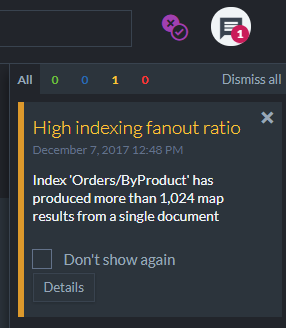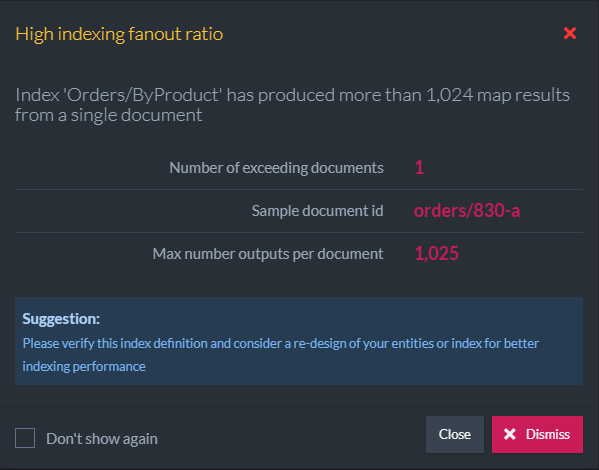Indexes: Fanout Indexes
The fanout index is the index that outputs multiple index entries per each document. Here is an example of such one:
public class Orders_ByProduct : AbstractIndexCreationTask<Order>
{
public Orders_ByProduct()
{
Map = orders => from order in orders
from orderLine in order.Lines
select new
{
orderLine.Product,
orderLine.ProductName
};
}
}public class Orders_ByProduct : AbstractJavaScriptIndexCreationTask
{
public Orders_ByProduct()
{
Maps = new HashSet<string>
{
@"map('Orders', function (order){
var res = [];
order.Lines.forEach(l => {
res.push({
Product: l.Product,
ProductName: l.ProductName
})
});
return res;
})",
};
}
}A large order, having a lot of line items, will create an index entry per each OrderLine item from the Lines collection. A single document can generate hundreds of index entries.
The fanout index concept is not specific for map-only indexes. It also applies to map-reduce indexes:
public class Product_Sales : AbstractIndexCreationTask<Order, Product_Sales.Result>
{
public class Result
{
public string Product { get; set; }
public int Count { get; set; }
public decimal Total;
}
public Product_Sales()
{
Map = orders => from order in orders
from line in order.Lines
select new Result
{
Product = line.Product,
Count = 1,
Total = ((line.Quantity*line.PricePerUnit)*(1 - line.Discount))
};
Reduce = results => from result in results
group result by result.Product
into g
select new
{
Product = g.Key,
Count = g.Sum(x => x.Count),
Total = g.Sum(x => x.Total)
};
}
}public class Product_Sales : AbstractJavaScriptIndexCreationTask
{
public class Result
{
public string Product { get; set; }
public int Count { get; set; }
public decimal Total { get; set; }
}
public Product_Sales()
{
Maps = new HashSet<string>()
{
@"map('orders', function(order){
var res = [];
order.Lines.forEach(l => {
res.push({
Product: l.Product,
Count: 1,
Total: (l.Quantity * l.PricePerUnit) * (1- l.Discount)
})
});
return res;
})"
};
Reduce = @"groupBy(x => x.Product)
.aggregate(g => {
return {
Product : g.key,
Count: g.values.reduce((sum, x) => x.Count + sum, 0),
Total: g.values.reduce((sum, x) => x.Total + sum, 0)
}
})";
}
}The above index definitions are correct. In both cases this is actually what we want. However, you need to be aware that fanout indexes are typically more expensive than regular ones. RavenDB has to index many more entries than usual. What can result is higher utilization of CPU and memory, and overall declining performance of the index.
Note
Starting from version 4.0, the fanout indexes won't error when the number of index entries created from a single document exceeds the configured limit. The configuration options from 3.x:
Raven/MaxSimpleIndexOutputsPerDocumentRaven/MaxMapReduceIndexOutputsPerDocument
are no longer valid.
RavenDB will give you a performance hint regarding high fanout ratio using the Studio's notification center.
Performance Hints
Once RavenDB notices that the number of indexing outputs created from a document is high, the notification that will appear in the Studio:

High indexing fanout ratio notification
The details will give you the following info:

Fanout index, performance hint details
You can control when a performance hint should be created using the PerformanceHints.Indexing.MaxIndexOutputsPerDocument setting (default: 1024).
Paging
Since the fanout index creates multiple entries for a single document and queries return documents by default (it can change if the query defines the projection) the paging of query results is a bit more complex. Please read the dedicated article about paging through tampered results.